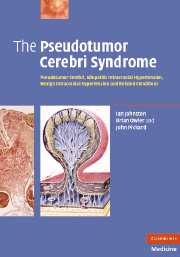 The Pseudotumor Cerebri Syndrome
The Pseudotumor Cerebri Syndrome Book contents
1 - Introduction
Published online by Cambridge University Press: 21 August 2009
Summary
The condition or syndrome to be considered in this monograph has been a clearly recognized clinical entity since the descriptions given by Quincke (1893, 1897) and Nonne (1904, 1914) over 100 years ago. However, reports of cases which were almost certainly examples of the same condition undoubtedly antedated their pioneering accounts by almost four decades. The essential elements of the syndrome are the symptoms and signs of intracranial hypertension without ventricular dilatation and without an intracranial mass lesion. For reasons which will be made clear in the following chapters, we shall call it the pseudotumor cerebri syndrome (PTCS) although quite a variety of terms have been applied to it. It is a particularly intriguing condition for a number of reasons, as follows:
Clinically the condition presents an essentially pure picture of raised intracranial pressure (ICP) without focal neurological disturbance and without investigative evidence of structural disturbance, either focal or general. As such, it is a condition which manifests, in isolation, what is a critical component of many neurological and neurosurgical conditions, i.e. intracranial hypertension, thereby creating a situation in which the pathological effects of this component exist in a pure form.
Despite much speculation and numerous clinical and laboratory studies (although clinical investigations are constrained by the exigent circumstances of the condition and laboratory studies by lack of a suitable model) there is still no clear consensus on its mechanism, although the predominant view is that the intracranial hypertension is due to a disturbance of cerebrospinal fluid (CSF) dynamics.
[…]
- Type
- Chapter
- Information
- The Pseudotumor Cerebri SyndromePseudotumor Cerebri, Idiopathic Intracranial Hypertension, Benign Intracranial Hypertension and Related Conditions, pp. 1 - 5Publisher: Cambridge University PressPrint publication year: 2007
- 2
- Cited by


